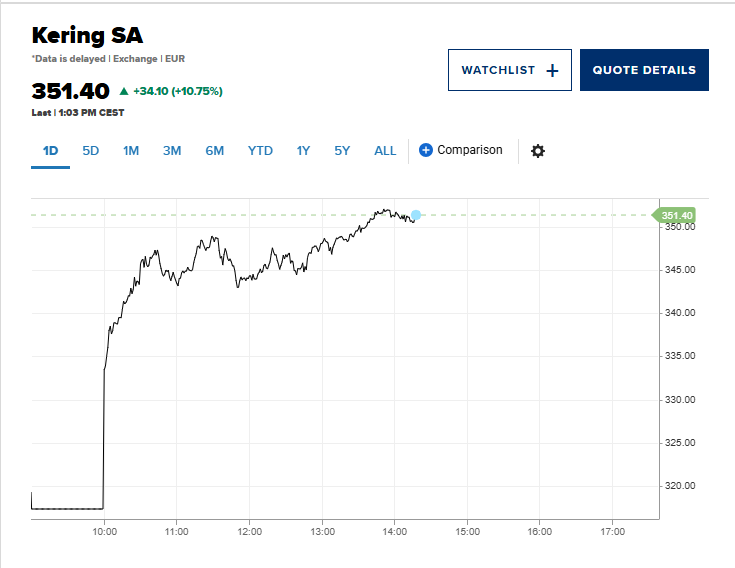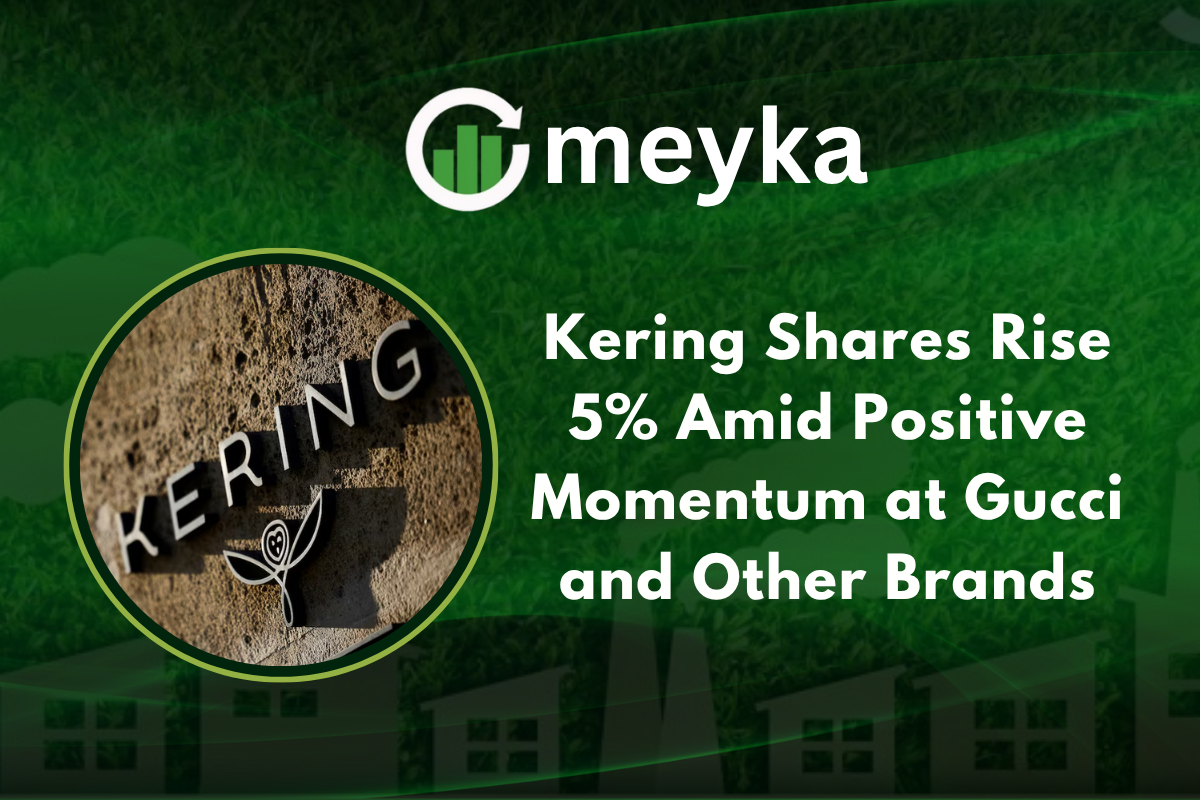Kering Shares Rise 5% Amid Positive Momentum at Gucci and Other Brands
The luxury market got a lift today as Kering shares rose about 5% on the Paris exchange. The jump followed company signals that Gucci and other brands are showing early signs of recovery.
Reports from Reuters, CNBC, The Wall Street Journal, and Brecorder say investors cheered stronger sales momentum and clearer brand direction.
Why did Kering move higher, and can that momentum last? Let’s break it down.
Why Did Kering Shares Rise Today?

Kering’s share gain came after the group reported sequential improvement at Gucci in the third quarter. Management said sales momentum was better than in recent months. That reassured investors that the turnaround plan is working.
Why did investors react so quickly? Because Gucci is the largest brand in the group, and signs of a recovery there lift the whole portfolio. CNBC reported stronger demand in key markets like China and the U.S., and that helped push the stock up.
A post from @classCNBC noted investor optimism at the market open:
Gucci at the Center of the Revival
Gucci still makes up a large part of Kering’s revenue. The brand has struggled with slowing demand and shifts in style preferences over the past year. Kering changed creative leadership and tightened its product strategy.
Now, company updates show early positive reactions to the new collections. Retail feedback and sales trends in Asia and North America appear better. That matters because Gucci’s health often sets the tone for the entire group.
Other Brands Also Showing Strength
Kering said that other houses, including Saint Laurent, Balenciaga, and Bottega Veneta, are also contributing to improved group performance. Saint Laurent showed steady growth. Bottega Veneta remains popular with loyal customers. Balenciaga is slowly stabilizing after past setbacks.
This broad-based improvement gave analysts more confidence. The Wall Street Journal reported that diversifying strength across brands made Kering’s recovery more believable.
A market note from @TheTranscript_ captured the mood, saying investors see tangible momentum across Kering’s labels:
Leadership and Strategy: Why It Matters
François-Henri Pinault, Kering’s chairman and CEO, stressed that the company is balancing short-term cost control with long-term brand building. Kering invested in creative talent, marketing, and digital tools. The strategy is to rebuild brand appeal and improve customer experiences.
What’s the plan?
- Renew creative identity at Gucci.
- Strengthen digital retail and client data.
- Tighten assortments to focus on high-quality, desirable items.
This strategy aims to restore both sales and margins over time.
Market Reaction and Analyst Views
Markets reacted quickly. Kering’s shares outpaced the CAC 40 after the update. Several analysts upgraded their tone on the stock. They noted a “credible path” to recovery based on early sales signs and better inventory management.
Analysts at major brokerages said the key test will be sustained quarterly improvement. A single quarter of better sales is positive, but investors want consistency. If Kering keeps showing growth, the stock could continue to gain.
The Luxury Sector Backdrop
The news comes in a mixed environment for luxury goods. Some giants like LVMH and Hermès remain strong. But a slowdown in China and currency swings have pressured many houses. Kering’s progress matters because it signals a potential shift in investor sentiment for fashion stocks across Europe.
Why Kering’s recovery is important: Gucci’s rebound could lift peer stocks. The luxury index showed modest gains after Kering’s news, suggesting investors are more willing to buy into a broader recovery story.
Gucci’s New Creative Direction
Under new creative leadership, Gucci is shifting toward refined elegance and quality. Early reactions from critics and customers show growing interest in the refreshed collections. This creative reboot appears to match a change in buyer tastes, focusing more on timeless design and craftsmanship than flashy logos.
This change could help Gucci regain cultural relevance. If customers respond, it should translate into steady sales and improved margins.
What This Means for Investors
So what should investors watch now?
- Consistency: Watch upcoming quarters for steady sales gains.
- Margins: Look for improvement in profit margins as higher-priced items sell.
- Geography: China and the U.S. remain critical; strong trends there matter most.
Short-term gains are encouraging. Long-term confidence depends on continued execution.
Analysts say the 5% rise is a vote of confidence, but not proof of full recovery. Kering must deliver repeated positive data to keep the momentum.
Risks and Remaining Challenges
Kering still faces hurdles. China’s demand can be volatile. Currency swings may hurt reported sales. Balenciaga must continue repairing its image after past controversies. And luxury markets often change quickly with consumer tastes.
Kering must keep aligning product, price, and brand storytelling. The company also needs to expand its digital reach and improve its store experience to meet modern luxury shoppers.
Why did Kering’s shares rise today? Because the company signaled sales momentum and early recovery at Gucci and other brands, which lifted investor confidence.
Can Kering sustain this gain? Sustained gains need consistent quarterly growth, margin improvement, and steady demand in top markets like China and the U.S.
Conclusion: Early Signs of a Comeback
Kering’s roughly 5% share rise reflects renewed investor hope that the group’s turnaround is working. Gucci’s early recovery and stable results from other houses underpin a positive view. The path ahead will test whether these gains turn into a lasting recovery.
For now, Kering has taken a small but meaningful step back into investor favor. If the group keeps showing sequential improvement, the market may reward it further. For the luxury sector, Kering’s rebound is a hopeful sign that strong brands can regain footfall and sales with the right strategy.
Kering is not back to peak form yet, but the latest signals show the group is moving in the right direction.
FAQ’S
Yes, Kering acquired Gucci in the early 2000s, gaining full ownership in 2004. Gucci remains Kering’s flagship luxury brand, contributing a major share of its revenue.
Kering’s share price has dropped due to slowing sales at Gucci, weaker luxury demand in China, and investor concerns over brand repositioning and profit margins.
Yes, Kering issued a profit warning earlier when Gucci’s sales fell sharply, signaling pressure on margins and slower recovery than expected in its key markets.
Kering is underperforming because Gucci’s turnaround has been slower than rivals, and competition from LVMH and Hermès remains strong amid global luxury market uncertainty.
Disclaimer
The content shared by Meyka AI PTY LTD is solely for research and informational purposes. Meyka is not a financial advisory service, and the information provided should not be considered investment or trading advice.






